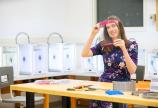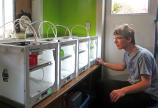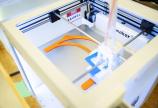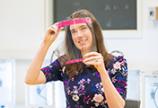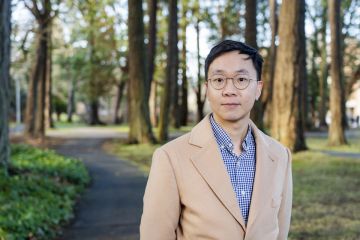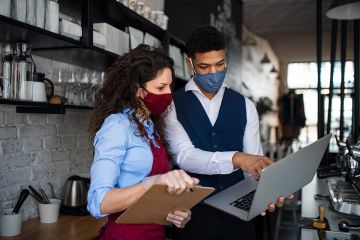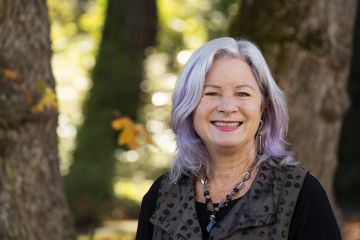New UVic initiative fashions face shields for frontline health workers
- Anne Tolson
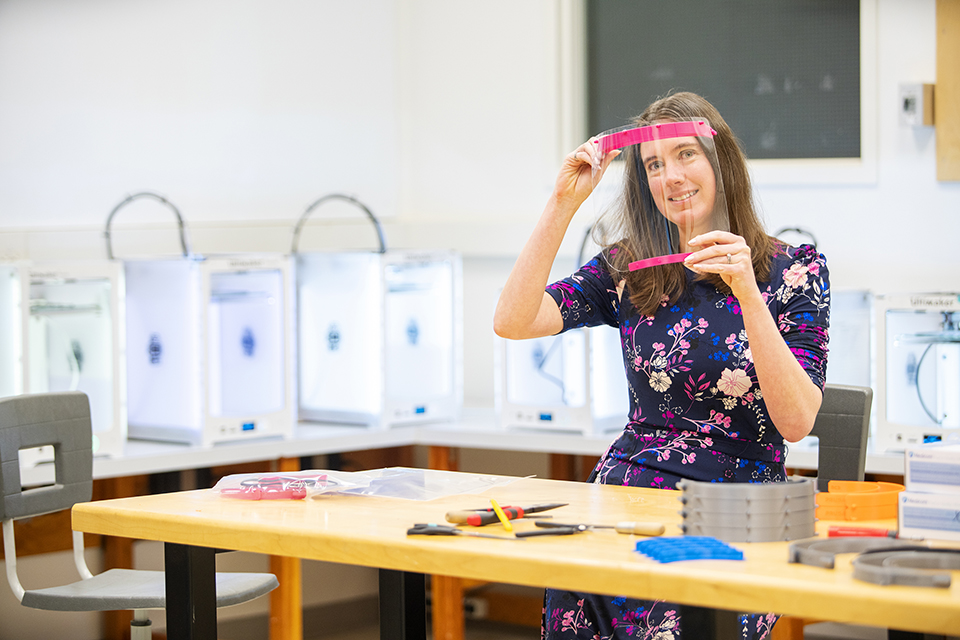
While UVic may seem strangely quiet these days, there are pockets of activity on campus where researchers are responding to the challenges of the COVID-19 pandemic.
Inside an engineering lab that has become the hub of a community effort to protect frontline health workers, stacks of medical-grade face shields are being prepared for delivery to Island Health.
“We all know that the COVID-19 pandemic has led to a worldwide shortage of disposable face masks,” said Stephanie Willerth, who leads the initiative and is director of UVic’s Biomedical Engineering Program. “So being able to use resources and production capacity from within the local community to produce face shields for our healthcare workers is really important.”
As a top research-intensive university in Canada, UVic knew it could contribute to the COVID-19 response. Although all but essential on-campus research was temporarily suspended on March 26, deans could approve exemptions for research and activities related to COVID-19.
Projects and research areas that are addressing the COVID-19 crisis include digital technologies, biomedical and biochemistry, genome research, proteomics, nursing, law, mathematics, social sciences, exercise science and 3D printing of supplies. There are approximately two dozen exempted research projects to date with more being proposed.
“UVic is one of Canada’s leading research universities and our researchers know they can have a vital impact working with our communities, governments, industry and other partners to tackle this global challenge,” said Lisa Kalynchuk, vice-president of research.
“I am proud of the commitment and innovation of our researchers as we continue to work together finding answers to the complexities of COVID-19.”
Willerth’s team is almost ready to deliver its first batch of face shields to Island Health—the first of 4,000 that will be provided at no cost to the health authority in the coming weeks.
The face shield’s components are being produced in an unlikely but impressive network of local businesses, research labs and even homes across the region. The components are then dropped in a bin outside UVic’s Engineering Lab Wing, where Willerth’s team inspects, assembles and packages them.
We've been linking with groups that are able to machine components and 3D print from all over the Island. It is definitely an amazing community effort.
— Stephanie Willerth, Director of UVic's Biomedical Engineering Program
Coast Capital Savings has donated $10,000 to support the initiative. In addition, numerous organizations and individuals have donated their time, equipment and materials.
“At a time when there is a need to come together like never before, it is heartwarming to see the ingenuity and creativity such as what we’re seeing from our partners at UVic,” said Maureen Young, director of Community Leadership at Coast Capital Savings. “Coast Capital Savings is humbled to be a small part of helping our frontline health workers as they do the most important work there is at this unprecedented moment in time.”
The idea for the initiative was hatched in an online health-focused chatroom when local doctors and nurses raised concerns about a shortage of disposable face masks and face shields that provide additional protection. UVic researchers and others began exploring possible solutions, settling on an open-source design that meets Health Canada’s specifications.
After Island Health approved a prototype that was produced by UVic and community partners, the call went out to local companies and individuals with the ability and capacity to machine or 3D print its components. About 20 3D printers are now working around the clock.
The transparent shield—which must also be made to exact specifications—is being laser cut by Foreman CNC Machining, a company in Sidney owned by UVic alumnus Chris Foreman. Some of the elasticized straps, which keep the shields in place, have been donated by community partners on Salt Spring Island.
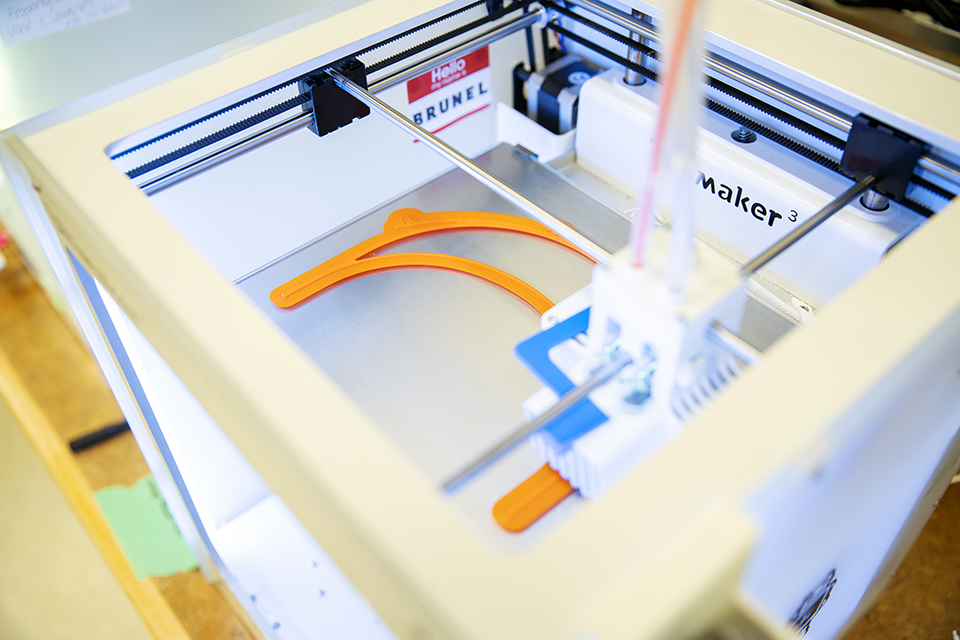
Several UVic alumni are involved in the initiative. James Tyrwhitt-Drake is playing a key role on several fronts, including sourcing materials, organizing volunteers and running a “print farm” in his own home made up of eight 3D printers, some of them borrowed from UVic’s Science Venture program.
“My primary hope is to save lives by supporting the heroic health care providers on the front line of this pandemic. They are putting themselves at risk looking after the people we love, and we are literally making armour for them to fight this virus,” said Tyrwhitt-Drake, who graduated in 2014. He currently works at Bryn Finer Studios, producing 3D topographic maps for Parks Canada visitor centres, and also as an instructor with Science Venture.
In Willerth’s lab, located in UVic’s Medical Sciences Building, a machine that emits ultra-violet rays is one of the methods being used to sterilize the shields and their packaging before they are sent to Island Health.
“Island Health has been working with Vancouver Island post-secondary institutions, including the University of Victoria, and other local producers to develop 3D printed and laser cut plastic prototypes for face shields that meet health system standards,” said James Hanson, Vice President, Operations and Support Services, at Island Health.
“We are grateful for these community efforts and partnerships.”
Less than a month ago, the UVic UV-emitting machine was being used by students and researchers for entirely different purposes: primarily to grow cells and tissues used in the study and treatment of a range of medical conditions.
But a lot has change in the past few weeks. Willerth and her colleagues in the Faculty of Engineering and the Coast Capital Innovation Centre hope to hire a larger cohort of co-op students than they usually do during the summer term to work on other COVID-19-related projects.
Interested in helping?
The face shield is 3D printed using an open source file created by Prusa Printers. People or businesses in the community who have 3D printers and the required materials (PLA and PETG) can help by printing off components and dropping them in the large container outside the doors of UVic’s Engineering Lab Wing (across from Parking Lot A) or at Phillips Beer Shop, 2010 Government St. (12-7 p.m. daily). Phillips Brewery is also donating 3D printed parts.
Q&A with James Tyrwhitt-Drake
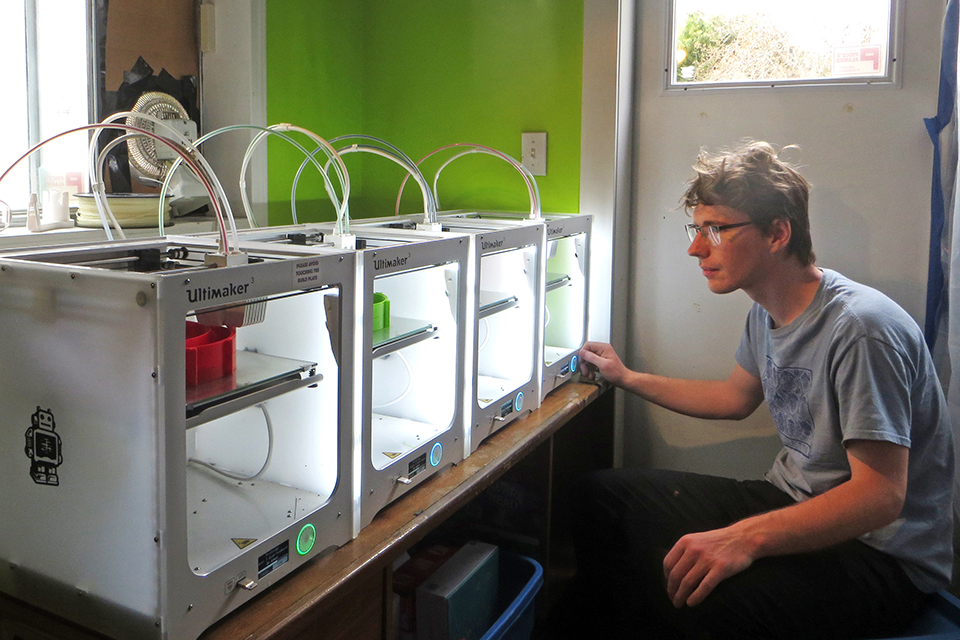
What has your role been in the face shield project?
I have two roles: organization and manufacturing. I'm working closely with the UVic face shield project and a similar group on Salt Spring Island to create assembly lines for face shields—sourcing materials, testing designs, figuring out sterilization and packaging, and working with volunteers to scale up production of 3D-printed parts. I've also been running a “print farm” in my house, using eight 3D printers to fabricate components for 100 face shields per day. It can be overwhelming, but it is also amazing to see so many people helping however they can.
What inspired you to get involved?
Prusa, a Czech 3D printer manufacturer, sent out a mass email to their customers on March 19, describing the 3D-printed face shields they had designed. It seemed like an effective way to use my skills to support health care providers. I connected with my colleagues on Salt Spring to organize an assembly line for face shields, and borrowed 3D printers from Science Venture—my employer at UVic. Through Science Venture, I connected with others at UVic who were also making face shields and we synchronized our efforts.
When did you graduate and in what?
I graduated from UVic in 2014 with a BSc in Biology, and my career has been focused on scientific visualization. From 2015 to 2017, I worked at the US National Institutes of Health on a project called the “NIH 3D Print Exchange,” which promotes the application of 3D printing in the biosciences.
Are you working now?
I currently work in science visualization with Bryn Finer Studios, producing 3D topographic maps for Parks Canada visitor centres. I also work in education, teaching students through Science Venture. Both my employers have been essential to getting this project going. (UVic’s Science Venture program has been delivering innovative science, technology, engineering and math programs to Vancouver Island youth since 1991.)
What is your hope for this project?
My primary hope is to save lives by supporting the heroic health care providers on the front line of this pandemic. They are putting themselves at risk looking after the people we love. We are literally making armour for them to fight this virus. If we can help them, there will be less suffering, fewer lives cut short, and our society will be able emerge from this crisis sooner rather than later.
Photos
In this story
Keywords: COVID, alumni, community, health, research, biomedical
People: Stephanie Willerth, Lisa Kalynchuk, James Tyrwhitt-Drake
Publication: The Ring

